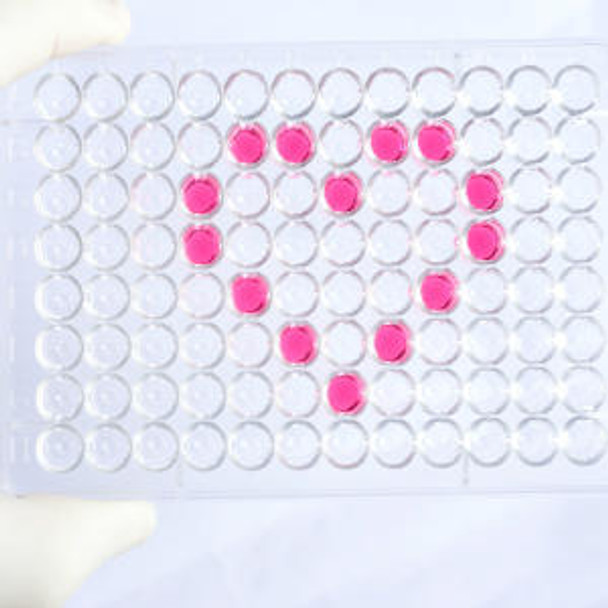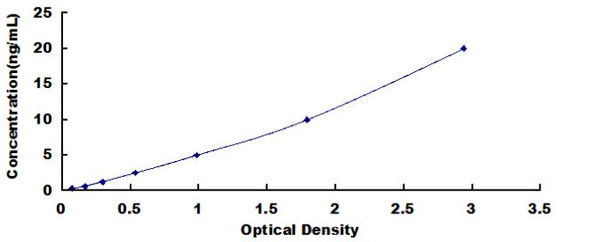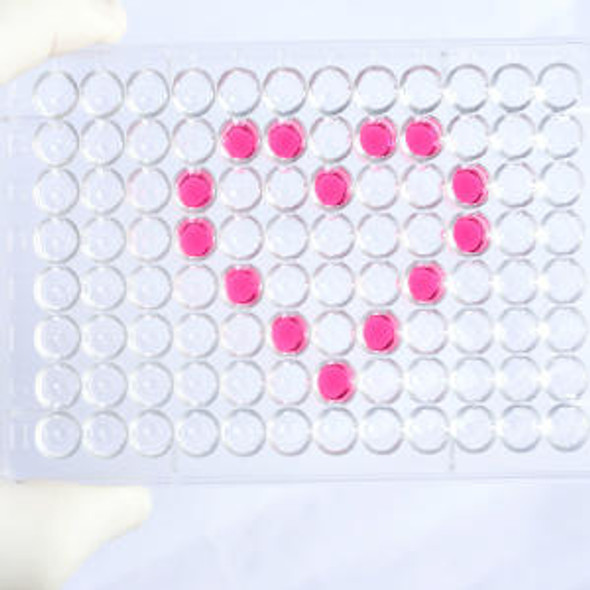Human Ephrin type-A receptor 4 (EPHA4) ELISA Kit (HUEB0566)
- SKU:
- HUEB0566
- Product Type:
- ELISA Kit
- Size:
- 96 Assays
- Uniprot:
- P54764
- Range:
- 15.6-1000 U/L
- ELISA Type:
- Sandwich
- Synonyms:
- EPHA4, Ephrin type-A receptor 4, Tyrosine-protein kinase receptor SEK, EPH-like kinase 8, EK8, hEK8, Tyrosine-protein kinase TYRO1
- Reactivity:
- Human
Description
Human Ephrin type-A receptor 4 (EPHA4) ELISA Kit
The Human Ephrin Type-A Receptor 4 (EphA4) ELISA Kit from Assay Genie is a state-of-the-art tool for accurate detection of EphA4 levels in human samples including serum, plasma, and cell culture supernatants. With its high sensitivity and specificity, this kit provides reliable and reproducible results, making it an invaluable asset for various research applications.EphA4 is a critical receptor protein involved in cell signaling and regulation, particularly in processes such as neuronal development, axon guidance, and synaptic plasticity.
Dysregulation of EphA4 has been associated with neurological disorders, spinal cord injuries, and certain cancers, highlighting its importance as a potential therapeutic target and biomarker for further study.Equip yourself with the Human EphA4 ELISA Kit from Assay Genie to unlock new insights into EphA4 biology and its implications in various diseases. Trust in its precision and accuracy to drive your research forward and uncover novel findings in the field of cellular signaling and neurobiology.
| Product Name: | Human Ephrin type-A receptor 4 (EPHA4) ELISA Kit |
| SKU: | HUEB0566 |
| Size: | 96T |
| Target: | Human Ephrin type-A receptor 4 (EPHA4) |
| Synonyms: | EPH-like kinase 8, Tyrosine-protein kinase TYRO1, Tyrosine-protein kinase receptor SEK, EK8, HEK8, SEK, TYRO1 |
| Assay Type: | Sandwich |
| Detection Method: | ELISA |
| Reactivity: | Human |
| Detection Range: | 15.6-1000U/L |
| Sensitivity: | 10U/L |
| Intra CV: | 4.5% | ||||||||||||||||||||
| Inter CV: | 9.8% | ||||||||||||||||||||
| Linearity: |
| ||||||||||||||||||||
| Recovery: |
| ||||||||||||||||||||
| Function: | Receptor tyrosine kinase which binds membrane-bound ephrin family ligands residing on adjacent cells, leading to contact-dependent bidirectional signaling into neighboring cells. The signaling pathway downstream of the receptor is referred to as forward signaling while the signaling pathway downstream of the ephrin ligand is referred to as reverse signaling. Highly promiscuous, it has the unique property among Eph receptors to bind and to be physiologically activated by both GPI-anchored ephrin-A and transmembrane ephrin-B ligands including EFNA1 and EFNB3. Upon activation by ephrin ligands, modulates cell morphology and integrin-dependent cell adhesion through regulation of the Rac, Rap and Rho GTPases activity. Plays an important role in the development of the nervous system controlling different steps of axonal guidance including the establishment of the corticospinal projections. May also control the segregation of motor and sensory axons during neuromuscular circuit development. In addition to its role in axonal guidance plays a role in synaptic plasticity. Activated by EFNA1 phosphorylates CDK5 at 'Tyr-15' which in turn phosphorylates NGEF regulating RHOA and dendritic spine morphogenesis. In the nervous system, plays also a role in repair after injury preventing axonal regeneration and in angiogenesis playing a role in central nervous system vascular formation. Additionally, its promiscuity makes it available to participate in a variety of cell-cell signaling regulating for instance the development of the thymic epithelium. |
| Uniprot: | P54764 |
| Sample Type: | Serum, plasma, tissue homogenates, cell culture supernates and other biological fluids |
| Specificity: | Natural and recombinant human Ephrin type-A receptor 4 |
| Sub Unit: | Heterotetramer upon binding of the ligand. The heterotetramer is composed of an ephrin dimer and a receptor dimer. Oligomerization is probably required to induce biological responses. Interacts (phosphorylated at position Tyr-602) with FYN. Interacts with CDK5, CDK5R1 and NGEF; upon activation by EFNA1 induces NGEF phosphorylation by the kinase CDK5. Interacts with CHN1; effector of EPHA4 in axon guidance linking EPHA4 activation to RAC1 regulation (By similarity). Interacts (via PDZ motif) with SIPA1L1 (via PDZ domain); controls neuronal morphology through regulation of the RAP1 (RAP1A or RAP1B) and RAP2 (RAP2A, RAP2B or RAP2C) GTPases. |
| Research Area: | Signal Transduction |
| Subcellular Location: | Cell membrane Single-pass type I membrane protein Cell projection Axon Cell projection Dendrite Cell junction Synapse Postsynaptic cell membrane Postsynaptic density Early endosome Clustered upon activation and targeted to early endosome. |
| Storage: | Please see kit components below for exact storage details |
| Note: | For research use only |
| UniProt Protein Function: | EphA4: a tyrosine kinase receptor of the Eph family. Receptor for members of the ephrin-A family. Binds to ephrin-A1, -A4 and -A5. Binds more poorly to ephrin-A2 and -A3. May play a role in hindbrain pattern formation. The Eph receptor tyrosine kinase family, the largest in the tyrosine kinase group, has fourteen members. They bind membrane-anchored ligands, ephrins, at sites of cell-cell contact, regulating the repulsion and adhesion of cells that underlie the establishment, maintenance, and remodeling of patterns of cellular organization. Eph signals are particularly important in regulating cell adhesion and cell migration during development, axon guidance, homeostasis and disease. EphA receptors bind to GPI-anchored ephrin-A ligands, while EphB receptors bind to ephrin-B proteins that have a transmembrane and cytoplasmic domain. Interactions between EphB receptor kinases and ephrin-B proteins transduce signals bidirectionally, signaling to both interacting cell types. Eph receptors and ephrins also regulate the adhesion of endothelial cells and are required for the remodeling of blood vessels. |
| UniProt Protein Details: | Protein type:EC 2.7.10.1; Kinase, protein; Protein kinase, tyrosine (receptor); Membrane protein, integral; Protein kinase, TK; TK group; Eph family Chromosomal Location of Human Ortholog: 2q36.1 Cellular Component: Golgi apparatus; cell surface; endoplasmic reticulum; integral to plasma membrane; postsynaptic density; dendrite; dendritic spine; perikaryon; postsynaptic membrane; mitochondrial outer membrane; axon; early endosome membrane; cytoplasm; plasma membrane; nerve terminal; neuromuscular junction; cell junction; filopodium Molecular Function:identical protein binding; protein binding; ephrin receptor binding; transmembrane-ephrin receptor activity; GPI-linked ephrin receptor activity; PH domain binding; ATP binding; protein kinase activity Biological Process: axon guidance; positive regulation of JNK activity; peptidyl-tyrosine phosphorylation; negative regulation of axon regeneration; protein amino acid autophosphorylation; motor axon guidance; regulation of astrocyte differentiation; positive regulation of dendrite morphogenesis; glial cell migration; regulation of axonogenesis; adult walking behavior; ephrin receptor signaling pathway; corticospinal tract morphogenesis; cell adhesion |
| NCBI Summary: | This gene belongs to the ephrin receptor subfamily of the protein-tyrosine kinase family. EPH and EPH-related receptors have been implicated in mediating developmental events, particularly in the nervous system. Receptors in the EPH subfamily typically have a single kinase domain and an extracellular region containing a Cys-rich domain and 2 fibronectin type III repeats. The ephrin receptors are divided into 2 groups based on the similarity of their extracellular domain sequences and their affinities for binding ephrin-A and ephrin-B ligands. [provided by RefSeq, Jul 2008] |
| UniProt Code: | P54764 |
| NCBI GenInfo Identifier: | 4758280 |
| NCBI Gene ID: | 2043 |
| NCBI Accession: | NP_004429.1 |
| UniProt Secondary Accession: | P54764,Q2M380, |
| UniProt Related Accession: | P54764 |
| Molecular Weight: | 109,860 Da |
| NCBI Full Name: | ephrin type-A receptor 4 |
| NCBI Synonym Full Names: | EPH receptor A4 |
| NCBI Official Symbol: | EPHA4 |
| NCBI Official Synonym Symbols: | SEK; HEK8; TYRO1 |
| NCBI Protein Information: | ephrin type-A receptor 4; EK8; EPH-like kinase 8; TYRO1 protein tyrosine kinase; tyrosine-protein kinase TYRO1; tyrosine-protein kinase receptor SEK; receptor protein-tyrosine kinase HEK8 |
| UniProt Protein Name: | Ephrin type-A receptor 4 |
| UniProt Synonym Protein Names: | EPH-like kinase 8; EK8; hEK8; Tyrosine-protein kinase TYRO1; Tyrosine-protein kinase receptor SEK |
| Protein Family: | Ephrin type-A receptor |
| UniProt Gene Name: | EPHA4 |
| UniProt Entry Name: | EPHA4_HUMAN |
| Component | Quantity (96 Assays) | Storage |
| ELISA Microplate (Dismountable) | 8×12 strips | -20°C |
| Lyophilized Standard | 2 | -20°C |
| Sample Diluent | 20ml | -20°C |
| Assay Diluent A | 10mL | -20°C |
| Assay Diluent B | 10mL | -20°C |
| Detection Reagent A | 120µL | -20°C |
| Detection Reagent B | 120µL | -20°C |
| Wash Buffer | 30mL | 4°C |
| Substrate | 10mL | 4°C |
| Stop Solution | 10mL | 4°C |
| Plate Sealer | 5 | - |
Other materials and equipment required:
- Microplate reader with 450 nm wavelength filter
- Multichannel Pipette, Pipette, microcentrifuge tubes and disposable pipette tips
- Incubator
- Deionized or distilled water
- Absorbent paper
- Buffer resevoir
*Note: The below protocol is a sample protocol. Protocols are specific to each batch/lot. For the correct instructions please follow the protocol included in your kit.
Allow all reagents to reach room temperature (Please do not dissolve the reagents at 37°C directly). All the reagents should be mixed thoroughly by gently swirling before pipetting. Avoid foaming. Keep appropriate numbers of strips for 1 experiment and remove extra strips from microtiter plate. Removed strips should be resealed and stored at -20°C until the kits expiry date. Prepare all reagents, working standards and samples as directed in the previous sections. Please predict the concentration before assaying. If values for these are not within the range of the standard curve, users must determine the optimal sample dilutions for their experiments. We recommend running all samples in duplicate.
| Step | |
| 1. | Add Sample: Add 100µL of Standard, Blank, or Sample per well. The blank well is added with Sample diluent. Solutions are added to the bottom of micro ELISA plate well, avoid inside wall touching and foaming as possible. Mix it gently. Cover the plate with sealer we provided. Incubate for 120 minutes at 37°C. |
| 2. | Remove the liquid from each well, don't wash. Add 100µL of Detection Reagent A working solution to each well. Cover with the Plate sealer. Gently tap the plate to ensure thorough mixing. Incubate for 1 hour at 37°C. Note: if Detection Reagent A appears cloudy warm to room temperature until solution is uniform. |
| 3. | Aspirate each well and wash, repeating the process three times. Wash by filling each well with Wash Buffer (approximately 400µL) (a squirt bottle, multi-channel pipette,manifold dispenser or automated washer are needed). Complete removal of liquid at each step is essential. After the last wash, completely remove remaining Wash Buffer by aspirating or decanting. Invert the plate and pat it against thick clean absorbent paper. |
| 4. | Add 100µL of Detection Reagent B working solution to each well. Cover with the Plate sealer. Incubate for 60 minutes at 37°C. |
| 5. | Repeat the wash process for five times as conducted in step 3. |
| 6. | Add 90µL of Substrate Solution to each well. Cover with a new Plate sealer and incubate for 10-20 minutes at 37°C. Protect the plate from light. The reaction time can be shortened or extended according to the actual color change, but this should not exceed more than 30 minutes. When apparent gradient appears in standard wells, user should terminatethe reaction. |
| 7. | Add 50µL of Stop Solution to each well. If color change does not appear uniform, gently tap the plate to ensure thorough mixing. |
| 8. | Determine the optical density (OD value) of each well at once, using a micro-plate reader set to 450 nm. User should open the micro-plate reader in advance, preheat the instrument, and set the testing parameters. |
| 9. | After experiment, store all reagents according to the specified storage temperature respectively until their expiry. |
When carrying out an ELISA assay it is important to prepare your samples in order to achieve the best possible results. Below we have a list of procedures for the preparation of samples for different sample types.
| Sample Type | Protocol |
| Serum | If using serum separator tubes, allow samples to clot for 30 minutes at room temperature. Centrifuge for 10 minutes at 1,000x g. Collect the serum fraction and assay promptly or aliquot and store the samples at -80°C. Avoid multiple freeze-thaw cycles. If serum separator tubes are not being used, allow samples to clot overnight at 2-8°C. Centrifuge for 10 minutes at 1,000x g. Remove serum and assay promptly or aliquot and store the samples at -80°C. Avoid multiple freeze-thaw cycles. |
| Plasma | Collect plasma using EDTA or heparin as an anticoagulant. Centrifuge samples at 4°C for 15 mins at 1000 × g within 30 mins of collection. Collect the plasma fraction and assay promptly or aliquot and store the samples at -80°C. Avoid multiple freeze-thaw cycles. Note: Over haemolysed samples are not suitable for use with this kit. |
| Urine & Cerebrospinal Fluid | Collect the urine (mid-stream) in a sterile container, centrifuge for 20 mins at 2000-3000 rpm. Remove supernatant and assay immediately. If any precipitation is detected, repeat the centrifugation step. A similar protocol can be used for cerebrospinal fluid. |
| Cell culture supernatant | Collect the cell culture media by pipette, followed by centrifugation at 4°C for 20 mins at 1500 rpm. Collect the clear supernatant and assay immediately. |
| Cell lysates | Solubilize cells in lysis buffer and allow to sit on ice for 30 minutes. Centrifuge tubes at 14,000 x g for 5 minutes to remove insoluble material. Aliquot the supernatant into a new tube and discard the remaining whole cell extract. Quantify total protein concentration using a total protein assay. Assay immediately or aliquot and store at ≤ -20 °C. |
| Tissue homogenates | The preparation of tissue homogenates will vary depending upon tissue type. Rinse tissue with 1X PBS to remove excess blood & homogenize in 20ml of 1X PBS (including protease inhibitors) and store overnight at ≤ -20°C. Two freeze-thaw cycles are required to break the cell membranes. To further disrupt the cell membranes you can sonicate the samples. Centrifuge homogenates for 5 mins at 5000xg. Remove the supernatant and assay immediately or aliquot and store at -20°C or -80°C. |
| Tissue lysates | Rinse tissue with PBS, cut into 1-2 mm pieces, and homogenize with a tissue homogenizer in PBS. Add an equal volume of RIPA buffer containing protease inhibitors and lyse tissues at room temperature for 30 minutes with gentle agitation. Centrifuge to remove debris. Quantify total protein concentration using a total protein assay. Assay immediately or aliquot and store at ≤ -20 °C. |
| Breast Milk | Collect milk samples and centrifuge at 10,000 x g for 60 min at 4°C. Aliquot the supernatant and assay. For long term use, store samples at -80°C. Minimize freeze/thaw cycles. |









